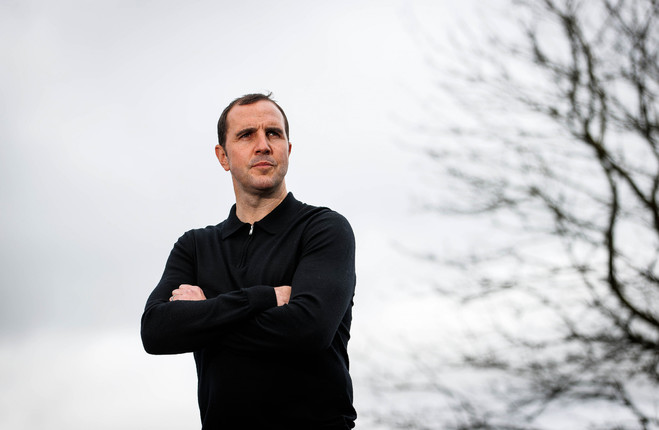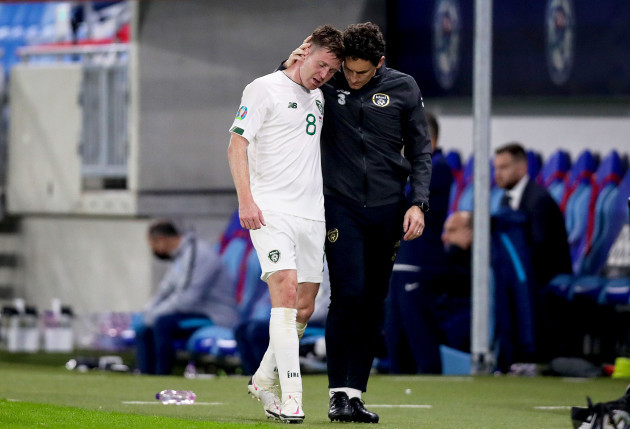WE REMEMBER JOHN O’Shea’s many successes, but one of his biggest disappointments was swept away by a wave of national exuberance.
Robbie Brady unleashed the tidal wave with his winning goal against Italy at Euro 2016, with O’Shea forced to watch from the bench. Having started both of the previous group games as captain, O’Shea was one of four front-liners dropped in the wake of the 3-0 trouncing by Belgium.
“That’s exactly what happens in management and in tournament football”, said O’Shea earlier this week when the topic was raised.
“We needed to get a win. It wasn’t nice, of course it wasn’t. I had played every game in the previous 10 or 11 years. But you that this is going to happen in your career at some stage.”
Given O’Neill’s style was to name the team a couple of hours before kick-off, O’Shea wasn’t sure he was going to be dropped until the evening of the game, but says a couple of his team-mates had heard mutterings to that effect.
“Ultimately, it was straight forward for me . You’re in a squad, you’re in a tournament and you’re doing everything that you can for Ireland to get results. It’s straightforward, you back the team and you back your team mates, you support your manager.”
That experience will inform O’Shea’s approach now that he is in charge.
“Hopefully a passion and an understanding of how to win football”, he replied when asked what he would bring to the job. “A successful playing career as you mention but I want to make sure everyone understands what it means when you’re in the squad first and foremost, when the team is named and how you support and how you understand to be successful in that unit.”
O’Shea has many of the qualities to succeed with Ireland but he, like his post-Rice predecessors, will be working within the squad’s limitations. Stephen Kenny’s legacy will be his very thorough scouting and squad-building, to the point that Ireland now have good-quality depth in most positions.
Our goalkeeper situation is of course the envy of all of Europe, while the five centre-backs in the squad are playing regularly in one of the Premier League, Ligue Un, or the top of the Scottish Premiership.
The squad is adequately stocked at full-back, while Kenny has unearthed several wingers. The number of strikers in the squad, meanwhile, can be measured in the absence of a national clamour to cap Nathan Fraser of Wolves.
But there’s one big hole in the squad and alas it is manifesting as a crater in the middle of the pitch. Ireland lack depth, physicality, and playmaking ability in the area in the game’s most important zone.
Options for this week have also been further depleted by injuries to Alan Browne, Jayson Molumby, and Jeff Hendrick.
Here’s the list of those named as midfielders for the upcoming games: Josh Cullen, Jason Knight, Will Smallbone, Jamie McGrath, Callum O’Dowda, Mark Sykes, Finn Azaz, Mikey Johnston. Joe Hodge and Andrew Moran will be added for the Swiss game, after their U21 commitments.
The most notable fact of that list of midfielders is that many are not actually midfielders. Johnston is a winger, and O’Dowda is another winger who has been retooled as a wing-back. Many of the remaining options play as attacking midfielders, or at least as attack-minded number eights in a 4-3-3. All of Azaz, Sykes, Moran, and McGrath fit this mould.
Hodge has played in a deeper role at underage international level but has been used as a number 10 on loan at QPR.
Hodge aside, Ireland’s other options at six or in a double pivot are Cullen, Knight, and Smallbone: all of whom have their qualities – and exemplary attitudes – but lack craft and physicality at senior international level.
While this Premier League season has been encouraging for Irish fans on a number of fronts, one of the big disappointments has been the fact Cullen has dropped out of the Burnley team, having been the centre of Vincent Kompany’s team in the Championship and at Anderlecht.
Ireland’s midfield has been a problem area ever since they allowed Declan Rice and Ethan Ampadu to slip through their fingers. Mick McCarthy recognised this when he returned, and brought back Glenn Whelan. A mid-2010s version of Whelan would be a genuinely transformative player in the current Irish squad.
It’s easy to forget that Stephen Kenny initially tried to build his midfield around James McCarthy, who is still just 33. The complete stalling of McCarthy’s career has been an under-discussed part of Ireland’s decline since 2018. He has spent this season rotting at Celtic, having played all of two games for the B team in the Lowland League, a level less competitive than the League of Ireland.
While Kenny trawled through passports to recruit wingers, he didn’t have the same success in central midfield.
Ireland must hope Hodge continues to develop and fulfill the potential he showed at the U19 Euros in 2019, despite his appalling luck with injuries.
It must also be hoped that Bosun Lawal maintains his progression, having impressed at Fleetwood during this loan spell from Celtic. Given Celtic’s status as a graveyard for Irish talent – Liam Scales and Adam Idah are happily bucking the trend at the moment – it is best if Lawal leaves to find regular football next season.
Other players who Ireland need to kick on are Baba Adeeko (Wigan) and Conor Coventry (Charlton).
Medium-term, the granny rule may hold the answer for Ireland. The up-side of England’s absurd production line is that only so many can actually be capped, so Ireland should not see themselves above capping the eligible among the jilted.
Leicester’s Kiernan Dewsbury-Hall is eligible for Ireland, for instance, but has not previously expressed an interest in switching. But with England’s midfield options absolutely stacked, the next Irish manager might calculate it worth a call. A longer-term target may be Dan Gore, currently coming through the ranks at Manchester United. He is understood to be eligible for Ireland if he wanted to play for us, so if he ever expresses an interest in doing so – and truthfully we don’t know whether he has been asked – the FAI should make it happen.
That’s all in the future. O’Shea the manager will this week reckon with the false horizon he viewed from the bench at Euro 2016. The James McCarthy, Robbie Brady and Jeff Hendrick midfield trio promised a future that never arrived, primarily because of injury.
Ireland need to identify options and build depth at midfield, as it is key to unlocking the obvious potential at either end of the pitch.



